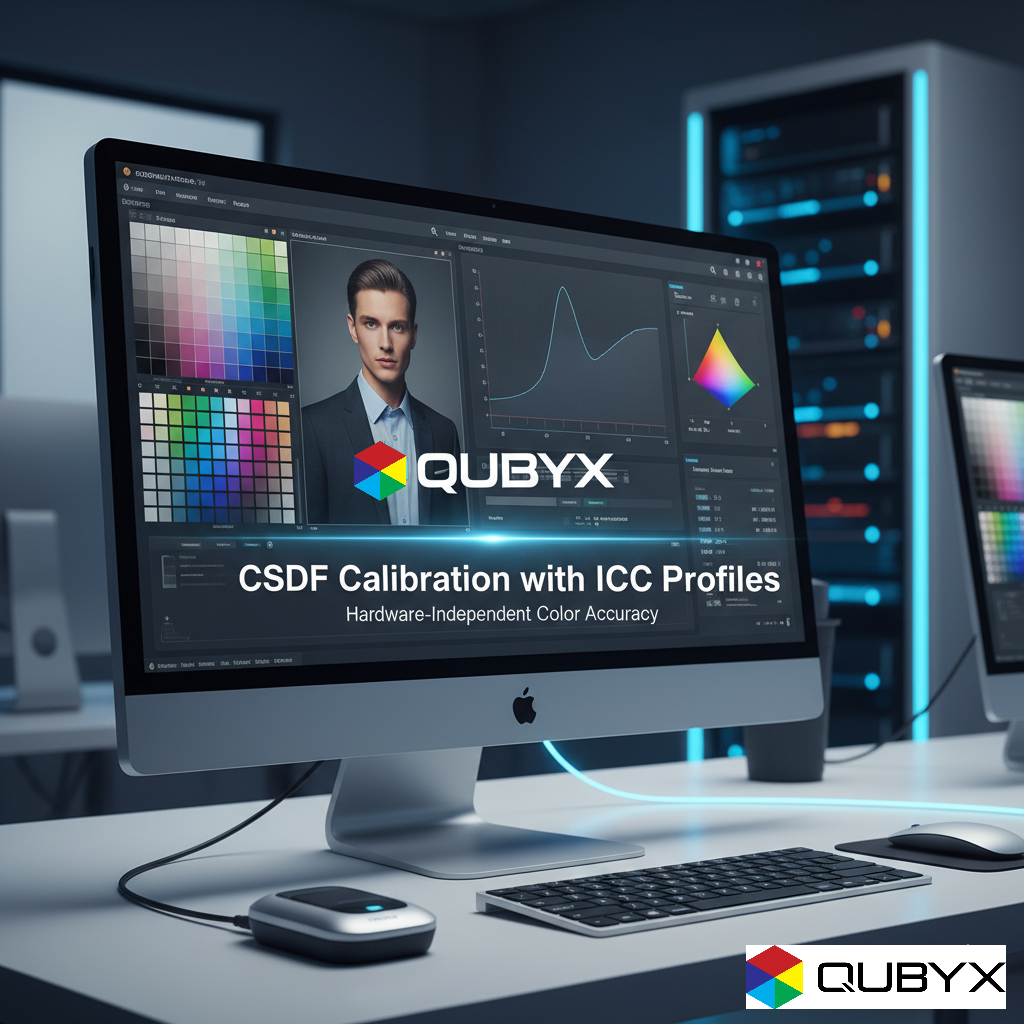News
- Home
- CSDF Calibration with ICC Profiles | Hardware-Independent Color Accuracy by QUBYX

CSDF Calibration with ICC Profiles | Hardware-Independent Color Accuracy by QUBYX
- October 9, 2025
- Shamsul
CSDF Calibration with ICC Profiles | Hardware-Independent Color Accuracy by QUBYX
1- Introduction: The Shift Toward Software-Defined Calibration
For decades, display calibration in medical, defense, and graphics industries depended heavily on expensive, hardware-specific solutions. These systems, while effective, created vendor lock-in and limited flexibility.
QUBYX was founded in 2002 by Dr. Marc Leppla (PhD, University of Nice Sophia Antipolis, France) — emerged as a leader in software-based calibration and verification, extending color precision from graphic arts to critical medical imaging.
Through innovative tools like PerfectLum and QUBYX OS Tools, QUBYX demonstrates how software-first calibration and ICC-based CSDF color mapping can deliver diagnostic-grade precision without costly hardware overhauls.
2- From QUATO to QUBYX: A Legacy of Precision
Before QUBYX, QUATO sarl (founded in 1996) produced scanners, calibration software, and high-quality displays for the graphics market. The evolution into QUBYX marked a shift toward software solutions that unify medical imaging, graphics, and defense visualization under one core principle:
“Accurate color should never depend on proprietary hardware.”
This mission aligns with the International Color Consortium (ICC) — founded to standardize open, cross-platform color management.
3- ICC Profiles: High Image Quality at Lower Cost
The ICC standard’s success rests on two pillars:
-
Higher color reproduction quality
-
Lower hardware dependency and cost
Before ICC color management, only high-end devices could deliver true-to-life image accuracy. Today, ICC profiles empower even budget monitors to reproduce colors faithfully across platforms.
In medical imaging, this philosophy is being realized through the integration of ICC color management within the DICOM standard — first introduced in 2005 (DICOM Supplement 100: Color Softcopy Presentation State) by NEMA.
ftp://medical.nema.org/medical/dicom/final/sup100_ft.pdf
The goal: bring the same democratization of color accuracy that revolutionized photography and printing into radiology, pathology, and endoscopy.
4- Evolution of Display Hardware
The rapid evolution of display technology supports this transformation:
-
4K/5K panels with pixel density up to 218 PPI (higher than legacy 5MP mammography monitors)
-
LED backlights with longer lifetimes and better uniformity
-
10-bit and 12-bit LUT support on modern GPUs
-
DisplayPort 1.3 with 8K and 16-bit pipeline support
-
Wide gamut panels approaching full Rec. 2020 coverage
These improvements reduce the gap between standard consumer displays and certified medical displays, making software calibration increasingly practical and reliable.
5- CSDF Calibration and the Role of ICC Profiles
The Color Standard Display Function (CSDF) calibration enhances the visual accuracy of grayscale and pseudo-color medical images. Traditionally, CSDF implementation relies on hardware-based cLUT (color Look-Up Table) systems — increasing cost and limiting flexibility.
QUBYX proposes a hardware-independent alternative using ICC profiles, enabling open, vendor-neutral, and cross-platform calibration.
Two Possible Implementations:
Solution 1: ICC DeviceLink Profiles
A DeviceLink profile provides a direct RGB-to-RGB transformation between uncalibrated and calibrated states.
These 3D LUT-based profiles:
-
Offer 16-bit precision and high transformation accuracy
-
Avoid intermediate RGB–XYZ–RGB conversions
-
Support quick switching between Color and GSDF modes
-
Maintain maximum color gamut and dynamic range
This approach allows grayscale or pseudo-color medical images to be automatically transformed before display — without altering the hardware LUT.
Solution 2: Specially Calculated ICC Profiles
Alternatively, a custom N-component LUT ICC profiles can be calculated for a given display to ensure evenly spaced CIE DE2000 color differences.
These profiles can:
-
Be applied directly to every grayscale or pseudo-color image
-
Function as working space profiles (like sRGB or Adobe RGB)
-
Enable consistent CSDF calibration for each modality
6- The Science Behind It: CIE L, GSDF, and Gamma*
Color perception is nonlinear. The CIE L* function approximates human brightness sensitivity, making colors appear equidistant for the observer.
By contrast, Gamma 2.2 — a relic from analog CRT systems — does not reflect perceptual linearity.
-
L* calibration improves shadow detail and mid-tone differentiation.
-
GSDF (Grayscale Standard Display Function) ensures consistent luminance across grayscale images.
-
CSDF extends this concept to color imaging.
When implemented via ICC profiles, these standards can coexist — enabling displays to toggle between GSDF, L*, or sRGB calibration curves depending on the imaging task.
7- Advantages of ICC-Based CSDF Calibration
| Aspect | Traditional Hardware LUT Calibration | ICC-Based CSDF Calibration (QUBYX) |
|---|---|---|
| Vendor Dependence | Proprietary hardware required | Open, cross-platform, vendor-neutral |
| Cost | High initial investment | Minimal (software-based) |
| Precision | Device-limited LUT precision | 16-bit 3D LUT via DeviceLink |
| Flexibility | Fixed per device | Easily switch between GSDF, L*, CSDF |
| Compatibility | Hardware-locked | Works with standard OS color management (Windows, macOS, Linux) |
This approach aligns perfectly with QUBYX’s OS Tools, enabling:
-
Full transparency through open-source frameworks
-
ICC DeviceLink generation and editing
-
Integration with standard PACS, DICOM viewers, and teleradiology setups
8- Beyond Grayscale: Pseudo-Color and dRGB Considerations
As noted by Craig Revie (2015), most medical images use pseudo-colors — derived from grayscale data for easier interpretation.
However, real-color modalities (e.g., endoscopy, ophthalmology) demand higher fidelity.
For these, CIE L* calibration is superior to Gamma-based models, ensuring perceptual uniformity across color scales.
Manufacturers of imaging systems such as endoscopy and pathology could align with Rec. 709 or Rec. 2020 standards for even greater consistency.
9- A Step Toward the Future: Open Standards in Medical Imaging
The inclusion of ICC profiles in DICOM (since Supplement 100) represents a paradigm shift — enabling color-managed, hardware-independent, software-controlled medical displays.
QUBYX, through continuous research and development, extends this concept further by merging CSDF calibration, ICC profiles, and open-source tools into a unified ecosystem for modern medical visualization.
10- Conclusion
CSDF calibration through ICC profiles is more than a technical improvement — it’s a strategic rethinking of how diagnostic image quality is achieved.
By embracing open ICC standards, DeviceLink transformations, and software-driven calibration, QUBYX delivers:
-
Higher image quality at a lower cost
-
Cross-platform interoperability
-
Freedom from hardware constraints
In short, QUBYX transforms calibration from a device-centric procedure into a universal, scalable, and accessible system for the medical imaging world.
Call to Action
Learn more about QUBYX OS Tools and PerfectLum Suite — the most advanced software-first calibration solutions for radiology, teleradiology, and clinical imaging environments.
Visit www.qubyx.com
To secure medical-grade display precision while reducing the recurring costs of proprietary hardware, the answer is clear: transition to a software calibration platform like QUBYX OS Tools (Free) and PerfectLum today.
Tags:
QUBYX, CSDF calibration, ICC profiles, hardware-independent calibration, medical imaging, DICOM GSDF, CIE L*, color management, DeviceLink profile, display calibration software
Related Posts
- October 9, 2025
- News
CSDF Calibration with ICC Profiles | Hardware-Independent Color Accuracy by
- October 8, 2025
- News
Avoid Costly Software for Imaging and Lower Hospital Cost Why
- October 8, 2025
- News
The Budget-Friendly Prescription | Using ICC Profiling to Dramatically Lower



